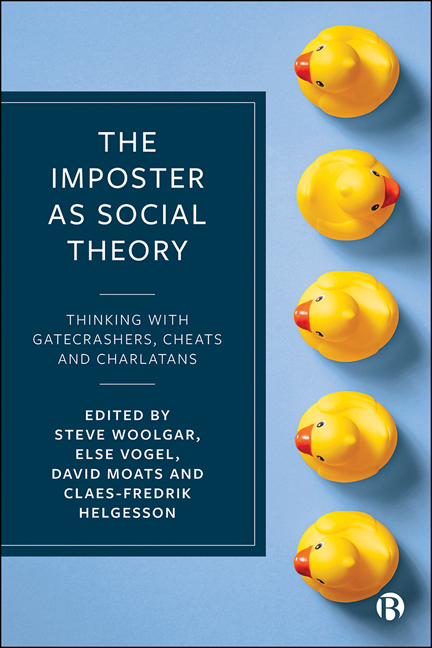Book contents
- Frontmatter
- Contents
- List of Figures and Boxes
- Notes on Contributors
- Preface
- 1 Thinking with Imposters: The Imposter as Analytic
- 2 The Desire to Believe and Belong: Wannabes and Their Audience in a North American Cultural Context
- 3 A Menagerie of Imposters and Truth-Tellers: Diederik Stapel and the Crisis in Psychology
- 4 Learning from Fakes: A Relational Approach
- 5 Imitations of Celebrity
- 6 Natural Imposters? A Cuckoo View of Social Relations
- 7 Conjuring Imposters: The Extraordinary Illusions of Mundanity
- 8 States of Imposture: Scroungerphobia and the Choreography of Suspicion
- 9 The Face of ‘the Other ’: Biometric Facial Recognition, Imposters and the Art of Outplaying Them
- 10 Faking Spirit Possession: Creating ‘Epistemic Murk ’ in Bahian Candomblé
- 11 The Guerrilla’s ID Card: Flatland against Fatland in Colombia
- 12 Good Enough Imposters: The Market for Instagram Followers in Indonesia and Beyond
- 13 Thinking beyond the Imposter: Gatecrashing Un/Welcoming Borders
- 14 Postscript: Thinking with Imposters – What Were They Thinking?
- Index
Preface
Published online by Cambridge University Press: 22 December 2021
- Frontmatter
- Contents
- List of Figures and Boxes
- Notes on Contributors
- Preface
- 1 Thinking with Imposters: The Imposter as Analytic
- 2 The Desire to Believe and Belong: Wannabes and Their Audience in a North American Cultural Context
- 3 A Menagerie of Imposters and Truth-Tellers: Diederik Stapel and the Crisis in Psychology
- 4 Learning from Fakes: A Relational Approach
- 5 Imitations of Celebrity
- 6 Natural Imposters? A Cuckoo View of Social Relations
- 7 Conjuring Imposters: The Extraordinary Illusions of Mundanity
- 8 States of Imposture: Scroungerphobia and the Choreography of Suspicion
- 9 The Face of ‘the Other ’: Biometric Facial Recognition, Imposters and the Art of Outplaying Them
- 10 Faking Spirit Possession: Creating ‘Epistemic Murk ’ in Bahian Candomblé
- 11 The Guerrilla’s ID Card: Flatland against Fatland in Colombia
- 12 Good Enough Imposters: The Market for Instagram Followers in Indonesia and Beyond
- 13 Thinking beyond the Imposter: Gatecrashing Un/Welcoming Borders
- 14 Postscript: Thinking with Imposters – What Were They Thinking?
- Index
Summary
On 10 December each year, Swedish national television (SVT) broadcasts live coverage of the Nobel Banquet. This four-and-a-half-hour extravaganza allows us to witness the assembly of the great and the good, celebrities, statesmen and royalty alongside the Nobel laureates and their families, attired in all their finery – some 1,300 guests in all. We watch them parading, dining, talking to one another and even, after the dinner, dancing. We hear the acceptance speeches and we are treated throughout to detailed expert commentary on what they are eating (there are interviews with the chefs and tastings with culinary experts) and what they are wearing (experts in high couture tell us how to appreciate the fashion on display).
The elaborate display of pageantry at the Nobel Banquet reinforces a sense of difference between those present and those watching from the outside. The message is that these guests are entitled to be there; they radiate a sense of privilege simply by being part of an exclusive occasion. For us onlookers, the question can arise: how might we become part of this? Short of actually becoming worthy of an invitation, how could one get into the banquet? What would it take to gatecrash this auspicious occasion? How could one imposter as one of these privileged few? Indeed, are imposters already present at the banquet, and how could one tell?
Distinctions between insiders and outsiders are made and sustained everywhere. During a meeting of our research group a casual discussion about the Nobel Banquet gradually morphed into a broader discussion. We found ourselves able to generate an apparently endless stream of idiosyncratic examples of impostering and of settings populated by imposters and gatecrashers. We quickly came to realise that impostering raises far more general and more pressing and significant issues than the example of the Nobel dinner with which we began, and takes us far beyond the questions of identity and belonging in which these discussions are often couched. From these conversations we set out to consider how the ubiquity of this troublesome figure might help us rethink some of social theory's core preoccupations.
The imposter is everywhere. The cases discussed in this volume attest to the richness and variety of examples of impostering. Our preoccupation with impostering derives not only from the seeming ubiquity of the imposter but also from a long-standing fascination with the relations between appearance and reality.
- Type
- Chapter
- Information
- The Imposter as Social TheoryThinking with Gatecrashers, Cheats and Charlatans, pp. xiv - xviPublisher: Bristol University PressPrint publication year: 2021



